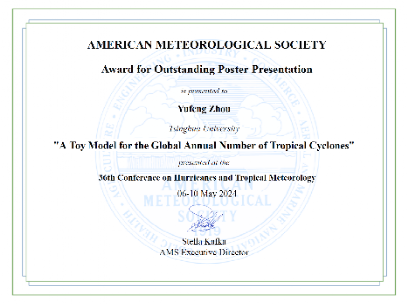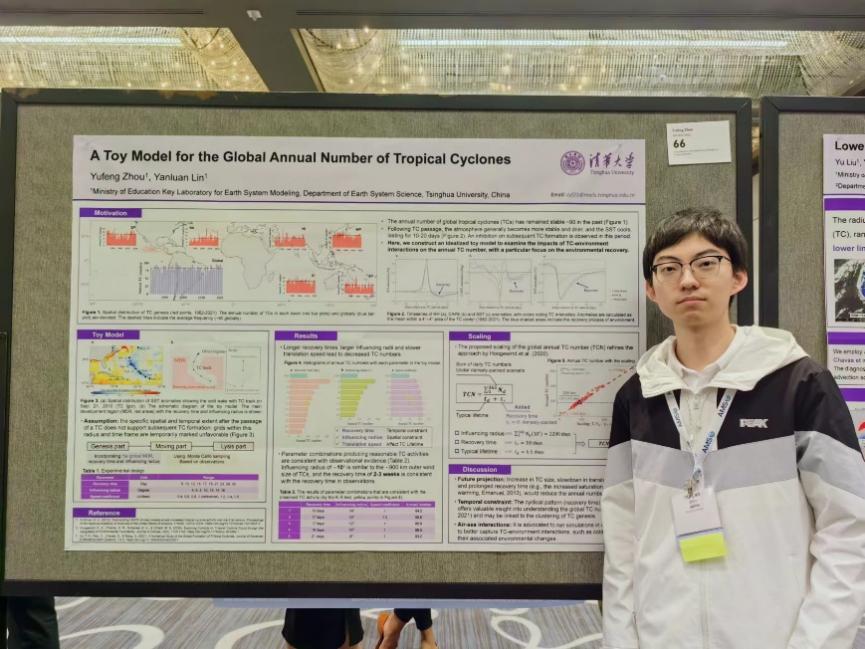The 36th Conference on Hurricanes and Tropical Meteorology of the American Meteorological Society (AMS) was held May 06-10 in Long Beach, California, USA. As the top academic conference in the field of global tropical cyclone research, this conference featured 76 sub-forums, covering such topics as tropical cyclone theory, observation, numerical simulation and climate change, with a total of more than 600 oral and poster presentations. The Outstanding Poster Presentation Awards and the Outstanding Oral Presentation Awards are awarded to four students. Zhou Yufeng, a doctoral candidate in Professor Lin Yanluan’s Research Group of the DESS, Tsinghua University, won the Outstanding Student Poster Presentation (1/4) at the conference, and he was the only award-winning graduate student from a university outside the United States.

Award certificate

Zhou Yufeng was at the conference poster site
The annual number of global tropical cyclones (TCs) has remained relatively stable at around 90 over the past 50 years, but the underlying mechanisms are not well understood. TCs are more likely to be generated in favorable environmental conditions (e.g., warm sea surface temperature, moist atmosphere). At the same time, TCs can make surrounding environmental conditions hostile (e.g., cooling the sea surface temperature), and thus limit the subsequent TC genesis in a short term. In this study, a toy model is proposed to explore the potential factors that constrain global TC numbers by focusing on TC-environment interactions and the recovery process. The recovery time and main development region (MDR) are introduced in the model to represent the environmental fields and constrain TC genesis and activity. A series of sensitivity tests indicated that a longer recovery time, a larger influencing radius, and slower TC translation speed all lead to a significant reduction in TC numbers. The study suggests that the recovery time of TC-environment interactions may be a potential factor that limits the frequency of TCs. For instance, the recovery time of sea surface cooling effect is about 2-3 weeks, possibly constraining the annual TC number in the current climate. The toy model also provides new insights for future projections, and suggests that the reduction of TC numbers may be related to a slowdown in the recovery process of TC-environmental interactions. In addition, we acknowledge that TC-environment interactions not only manifest in the observed sea surface cooling effect (TC cold wake), but also in the large-scale environmental conditions, such as relative humidity. Therefore, the recovery time of TC-environment interactions, which includes both the ocean and atmosphere aspects, may be a potential factor limiting the frequency of global TCs. Overall, this study provides insights into the possible mechanisms and factors that influence global TC numbers, and contributes to our understanding of the potential impacts of climate change on TCs.
Tropical cyclones (TCs) are very destructive weather systems, with their destructiveness closely related to the frequency of occurrence. The annual number of TCs has remained relatively stable at around 90 over the past decades, but the underlying mechanisms are not well understood. Based on 40-year observation data, this study assesses the complex interaction between TCs and the environment. It is pointed out that TCs can make surrounding environmental conditions hostile, and thus limit the subsequent TC genesis in a short term. By constructing an ideal model and carrying out simulation research, the parameters such as the recovery time of the environment and the influence range of TCs are defined, and the constraints on the number and activities of TCs are quantitatively studied from the perspective of time and space. On this basis, a new way for assessing global TCs number is proposed by introducing recovery time, pointing out that the recovery time of sea surface cooling effect is about 2-3 weeks, possibly constraining the annual TC number (about 90 annually) in the current climate. This discovery stresses TC-environment interaction, especially the important impact of air-sea interactions on TCs number and activities, contributing a new approach to climatic prediction of TCs activities.
Professor Lin Yanluan's Research Group of the DESS has been long engaged in TC-related work, pursuing research around the structure, size, enhancement mechanism, climate effect and case simulation analysis of TCs, and constantly offering new insights, with reference and guiding significance for typhoon and its precipitation forecast and disaster prevention and reduction in China. In addition, the Research Group, with a focus on the development of weather and climate model and extreme precipitation process, develops several cloud and precipitation parameterization schemes to improve the performance of weather and climate models.
Award announcement on the conference official website:
https://ams.confex.com/ams/36Hurricanes/meetingapp.cgi/Index/StudentAwardWinner~1
Written by Zhou Yufeng